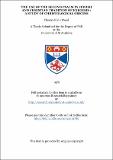Files in this item
The use of the second Psalm in Jewish and Christian tradition of exegesis : a study of Christological origins
Item metadata
| dc.contributor.author | Wood, Chester Elvin | |
| dc.coverage.spatial | vi, 359 p. | en_US |
| dc.date.accessioned | 2018-06-07T08:28:48Z | |
| dc.date.available | 2018-06-07T08:28:48Z | |
| dc.date.issued | 1976-07 | |
| dc.identifier.uri | https://hdl.handle.net/10023/13789 | |
| dc.description.abstract | The purpose of this dissertation is to examine the use of the second Psalm in Jewish and Christian tradition of exegesis. This study begins with the O.T. itself and traces the employment of Ps. 2 in Jewish and Christian literature up to 300 A.D. As the sub-title indicates the focus of this inquiry is the christological employment of Ps. 2 by N.T. writers. Ch. I gives detailed consideration to Ps. 2:1, 2, 7-9 (i.e. those verse used in the N.T.) in its O.T. context. This is necessary because it is impossible to relate the later uses of Ps. 2 to its original meaning unless this has been ascertained. Such problems as the scope of the rebellion (vss. 1, 2), the significance of חֹק and "you are my Son, today I have begotten you" (vs. 7), the pointing of תרעם (vs. 9), the place of Ps. 2 in its O.T. Traditionsgeschichte, the relation of the M.T. to the LXX, other Greek versions and the Targum and the messianic nature of Ps. 2 are taken up. Ch. II, intertestamental literature (i.e., D.S.S., Apocrypha, Pseudepigrapha, Rabbinic literature), examines the quotation of Ps, 2:1,2 in 4QFlor 1 : 18ff, the allusion to Ps. 2:7 in IQSa 2:11, the clearly messianic use of Ps. 2:9 in Psalms of Solomon 17:26 along with allusions to Ps, 2:2,9 in Psalms of Solomon 17,18. Attention is given to allusions to Ps. 2 in Wisdom of Solomon, Sirach, IV Ezra and I Enoch. The occurrences of Ps. 2 in the Rabbinic literature are only surveyed because in most cases the traditions preserved in this literature cannot be shown to be pre-Christian. Finally, the use of Son of God as a messianic title in pre-Christian Judaism is sketched. Ch. III-V deal with the N.T. and concentrate upon the following areas of inquiry: l) introductory formula, 2) text form, 3) contribution of the quotation to the argument or theme of the passage, i.e. what is the significance of the quotation, 4) function of the quotation, i.e. how is it used in its immediate and wider context, 5) hermeneutical stance and techniques and 6) the relation of the quotation or the allusion to earlier and later Traditionsgeschichte. Ch. III examines the use of Ps. 2:1,2 in Acts 3:18,4:5,25ff, Mt. 22:34. Ch. IV deals with Ps. 2:7 in Acts 13:33, Heb. 1:2,5, 5:5, 7:28 and the alleged allusions in the baptism and transfiguration voices and Rom. 1:4. Ch. V is concerned with Ps. 2:9 in 2,26,27, 12:5, 19:15 and allusions to Ps. 2:2 in 11:15, 12:10, 19:19. The use of Ps. 2 in the Church Fathers is incorporated in chs. III-V. | en_US |
| dc.language.iso | en | en_US |
| dc.publisher | University of St Andrews | |
| dc.subject.lcc | BS1450.W7 | en |
| dc.subject.lcsh | Bible. Psalms, II--Criticism, interpretation, etc | en |
| dc.title | The use of the second Psalm in Jewish and Christian tradition of exegesis : a study of Christological origins | en_US |
| dc.type | Thesis | en_US |
| dc.type.qualificationlevel | Doctoral | en_US |
| dc.type.qualificationname | PhD Doctor of Philosophy | en_US |
| dc.publisher.institution | The University of St Andrews | en_US |
This item appears in the following Collection(s)
Items in the St Andrews Research Repository are protected by copyright, with all rights reserved, unless otherwise indicated.

